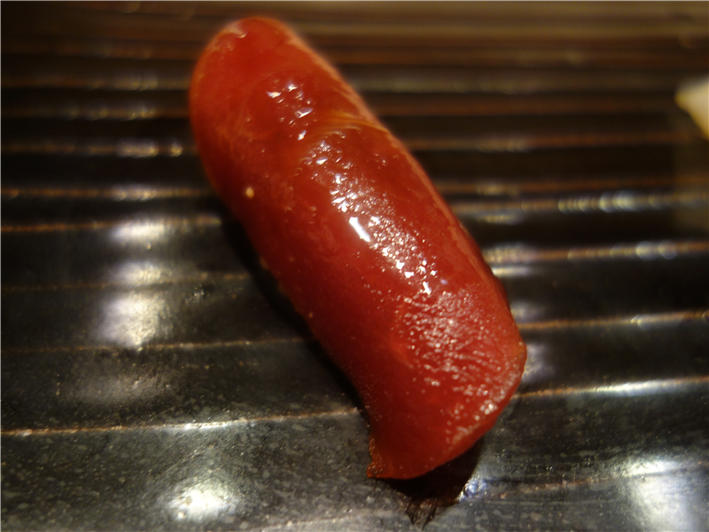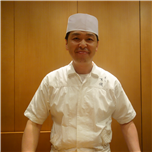Editor's note: Sushi Shikon moved to the Landmark Mandarin Oriental in 2019.
Sushi Shikon (formerly named Sushi Yoshitake) is the younger sister of the original Sushi Yoshitake in Tokyo. It was awarded two Michelin stars in the 2013 Michelin guide, then in the 2014 guide Shikon was awarded a third star, which brought it in line with its Tokyo sibling. The name means “spirit of challenge” in Japanese.
Head chef is Sushi Yoshitake's former sous chef Yoshiharu Kakinuma. He worked for a time in Atlanta, Georgia and also in New York City for a short period before moving to Tokyo, and now to Hong Kong. The chefs in the kitchen have worked at the Tokyo restaurant for several years. Live produce is flown in twice daily from Tsukiji market in Tokyo, and even the water, coal and gas used here are brought in from Japan in order to precisely recreate the standards of the original restaurant.
On the ground floor of the boutique Mercer Hotel, this establishment opened in late 2012 and was originally called Sushi Yoshitake Hong Kong, but was rebranded in 2013 as Sushi Shikon. I was curious as to why the name had changed but seemingly it was because a few customers had booked at one restaurant by phone but had turned up to the other by mistake. Such no shows are a real problem in a restaurant with eight seats. Sushi Shikon is of the same scale as many top Tokyo sushi bars, with just a single private dining room for six, and eight seats arrayed along its hinoki (Japanese cypress) counter, cut from a single piece of wood. The sushi rice is prepared with red vinegar in the traditional edomae style originally developed in what is now Tokyo in the 1820s (there are different styles of sushi such as the pressed sushi of Osaka, where a wooden mould is used to press the rice into a rectangular shape).
The meal began with baby squid with a spring mountain vegetable, a type of hosta, dressed with miso vinegar. The squid was extremely tender, and the vinegar had just the right amount of sourness to balance the squid. Wasabi root was grated fresh and sourced from Japan, as indeed are all the ingredients here.
Octopus was served with daikon pickle and wasabi. Even in serious restaurants in Japan, octopus can be challenging to eat, but it was genuinely tender, served with daikon pickle. Sea bream had unusually soft texture, having been cured with seaweed, and was served with a fish bone soy sauce made here from scratch.
Abalone is steamed for around five hours (depending on the specific shellfish) and served with a delicate sauce of abalone liver. Next was mackerel, smoked in hay and seared on one side, served with Japanese horseradish mixed with ginger and scallion. This dish was absolutely superb, the flavour of the mackerel remarkable.
Green sea urchin from Hokkaido was served with wasabi flower and mountain yam, the urchin a velvety delight. Squid sushi followed, the flesh superbly tender. This was followed by golden eye snapper sushi, which had terrific flavour. Akamai tuna sushi was magnificent, followed by otoro sushi and then served otoro. An unusual dish was aburi, the tendon of the tuna that had been marinated and cooked over charcoal - a lovely flavour with the tuna combining with the smokiness of the bincho charcoal.
Next was shad cured with vinegar and served with pickled ginger, mint and sesame with white kelp. This was followed by sushi of smoked Spanish mackerel topped with freshly grated yuzu zest. Both purple and green uni were combined in a superb roll, then came prawn sushi with shrimp paste. Sea eel sushi had superb flavour, followed by tuna and pickle roll.
The traditional way to finish a sushi meal is with tomago, an egg custard, and here it had very light texture indeed (18/20). Finally there was orange jelly presented in a hollowed out orange, the fruit directly from Japan. The jelly had lovely texture and terrific flavour, and could have happily appeared in a serious restaurant in France (18/20).
The chef speaks fluent English and was genuinely charming, happy to chat about each dish in depth. The bill came to HK$ 7,823 for two, which works out at £303 a head, with beer to drink. Of course this is a lot of money, but all the fish is flown in daily from Japan and the standard was superb, every bit as good as the top restaurants in Tokyo.
As noted elsewhere, I struggle to justify assigning my ultimate scores above 18/20 to a style of restaurant that in some sense has limited intervention with its ingredients, but this was right up there with the top sushi restaurants of Japan; it thoroughly deserves its three Michelin stars as a sushi restaurant.







Christian Romanowski
Thank You for this helpful review! :-)
Josh Bartel
Atlanta certainly misses Kaki. Here is my review of the omakase service at Nakato, his previous restaurant: http://chowhound.chow.com/topics/853475